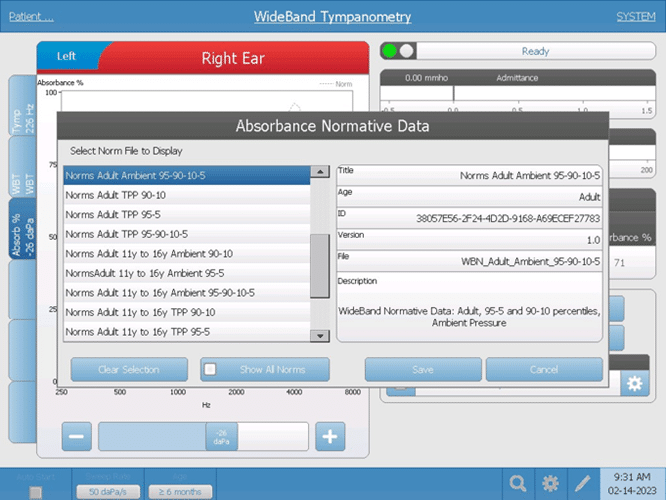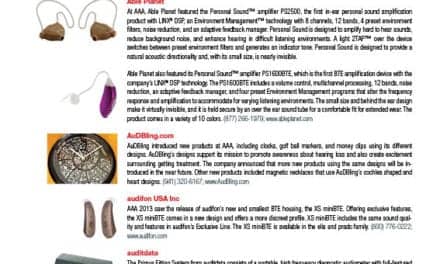By Laura Prigge, AuD
Wideband tympanometry (WBT) is a newer hearing test that provides a comprehensive set of data on the status of the middle ear. While adding a new test protocol can be intimidating, WBT adds no additional time to patient evaluations and still provides familiar middle ear measurements. WBT is now available on clinical tympanometers, including the GSI TympStar Pro. This article will discuss how to seamlessly incorporate WBT into a patient evaluation, discuss normative data and example data, and provide references for additional information.
Implementation of WBT can be seamless. It is recommended that WBT be performed on every patient. The procedure is the same as tympanometry and takes the same amount of time. When complete, traditional single frequency tracings are displayed. The initial results screen includes tympanograms performed with 226 Hz, 678 Hz, 800 Hz, and 1000 Hz probe tones. Tympanic peak pressure (TPP), admittance at peak, and ear canal volume are automatically displayed for each. Providing 226 Hz and 1000 Hz tympanograms with one pressure sweep can save time when testing infants under the age of one year where either probe tone may be appropriate.
The TympStar Pro also displays the wideband average tympanogram (WAT). This measurement averages a group of single frequency tympanograms into one tracing. Reviewing the averaged tympanogram is helpful when the patient is noisy or moves during the measurement. The resultant tympanogram is smooth and easier to interpret because artifacts and noise are averaged out.
Finally, wideband tympanometry provides the middle ear absorbance graph. Absorbance is the amount of acoustic energy transmitted or absorbed by the middle ear expressed as a percentage across the frequencies of the wideband stimulus. The absorbance graph of the middle ear has distinctive patterns depending on the age of the patient and status of the middle ear. The TympStar Pro includes many tools to assist in interpreting the results. There are normative data for every patient population. For infants, the norms include the following: Newborn, .5 months to 2 months, and 2 months to 6 months. For adults, the norms include the following: 6 months to 3 years, 3 to 11 years, 11 to 16 years, and adult. These are easily overlaid on the absorbance graph with just a few screen touches.

Information on the normative studies can be found here:
•Sanford, C.A., Keefe, D.H., Liu, Y., Fitzpatrick, D.F., McCreery, R.W., Lewis, D.E. & Gorga, M.P. (2009). Sound conduction effects on DPOAE screening outcomes in newborn infants: Test performance of wideband acoustic transfer functions and 1-kHz tympanometry. Ear and Hearing, 30(6), 635-652.
•Liu, Y., Sanford, C.A., Ellison, J.C., Fitzpatrick, D.F., Gorga, M.P., & Keefe, D.H. (2008). Wideband absorbance tympanometry using pressure sweeps: System development and results on adults with normal hearing. Journal of the Acoustical Society of America, 124(6) 3708-3719.
WBT is sensitive to many ear disorders. Each disorder has a distinct configuration and has been documented in peer reviewed publications. The TympStar Pro includes example data for some of the most common disorders: blocked probe, loose fit, negative pressure, ossicular discontinuity, otosclerosis, perforation, and middle ear effusion. These examples can be overlaid on the absorbance graph to guide interpretation.

I believe that WBT is the future of middle ear testing, and there are new studies published every month in a variety of peer-reviewed journals supporting this view. Below is a list of reference articles that can be accessed to learn more about why wideband tympanometry is the preferred method of middle ear analysis starting now.
- Thieme E-Books & E-Journals – Seminars in Hearing / Issue (thieme-connect.com) (Feb 2023)
- Feeney MP, Hunter LL, Kei J. et al. Consensus statement: Eriksholm workshop on wideband absorbance measures of the middle ear.Ear Hear 2013;34 (Suppl. 01) 78S-79S.
- Gabrielle R. Merchant,1 Sarah Al-Salim,2 Richard M. Tempero,3 Denis Fitzpatrick,1
and Stephen T. Neely1. Improving the Differential Diagnosis of Otitis Media With Effusion
Using Wideband Acoustic Immittance - Sanford, C.A., Keefe, D.H., Liu, Y., Fitzpatrick, D.F., McCreery, R.W., Lewis, D.E. & Gorga, M.P. (2009). Sound conduction effects on DPOAE screening outcomes in newborn infants: Test performance of wideband acoustic transfer functions and 1-kHz tympanometry. Ear and Hearing, 30(6), 635-652.
- Liu, Y., Sanford, C.A., Ellison, J.C., Fitzpatrick, D.F., Gorga, M.P., & Keefe, D.H. (2008). Wideband absorbance tympanometry using pressure sweeps: System development and results on adults with normal hearing. Journal of the Acoustical Society of America, 124(6) 3708-3719.
- Pieterse H, Biagio-De Jager L, Hofmeyr LM, Vinck BHME. Wideband acoustic immittance in superior semicircular canal dehiscence. Auris Nasus Larynx. 2022 Dec;49(6):921-927. doi: 10.1016/j.anl.2022.03.008. Epub 2022 Mar 27. PMID: 35351349.
- Velikoselskii A, Papatziamos G, Smeds H, Verrecchia L. Wideband tympanometry in ears with superior canal dehiscence before and after surgical correction. Int J Audiol. 2022 Aug;61(8):692-697. doi: 10.1080/14992027.2021.1964041. Epub 2021 Aug 21. PMID: 34420430.
- Liu J, Jiang W, Lin H, Li H, Tong Y, Liu W, Qiao Y. [A preliminary study on characteristics of wideband acoustic immittance in patients with Meniere’s disease]. Lin Chuang Er Bi Yan Hou Tou Jing Wai Ke Za Zhi. 2021 Dec;35(12):1068-1072. Chinese. doi: 10.13201/j.issn.2096-7993.2021.12.003. PMID: 34886618; PMCID: PMC10127658.
- Merchant GR, Al-Salim S, Tempero RM, Fitzpatrick D, Neely ST. Improving the Differential Diagnosis of Otitis Media With Effusion Using Wideband Acoustic Immittance. Ear Hear. 2021 Sep/Oct;42(5):1183-1194. doi: 10.1097/AUD.0000000000001037. PMID: 33928915; PMCID: PMC8387322.
- Navid Shahnaz, Neil Longridge & Desmond Bell (2009) Wideband energy reflectance patterns in preoperative and post-operative otosclerotic ears, International Journal of Audiology, 48:5, 240-247, DOI: 10.1080/14992020802635317
- Rosowski JJ, Stenfelt S, Lilly D. An overview of wideband immittance measurements techniques and terminology: you say absorbance, I say reflectance. Ear Hear. 2013 Jul;34 Suppl 1(0 1):9S-16S. doi: 10.1097/AUD.0b013e31829d5a14. PMID: 23900187; PMCID: PMC3800001.
- Seminars in Hearing; Issue 01. Vol 44. February 2023. Assessment of Middle Ear Function Using Wideband Acoustic Immittance: Current Practices and Future Prospects. Guest Editor, Hammam AlMakadma, Ph.D., Au.D.
- Biswas, Anirban, Dutta, Nilotpal. Wideband Tympanometry. Ann Otol Neurotol ISA 2018: 1:126-132
Additional information about wideband tympanometry with the TympStar Pro can be found here: https://www.grason-stadler.com/wideband-tympanometry.
Featured image: GSI The TympStar Pro can be used for the implementation and interpretation of WideBand Tympanometry. Photo: Grason Stadler/GSI





